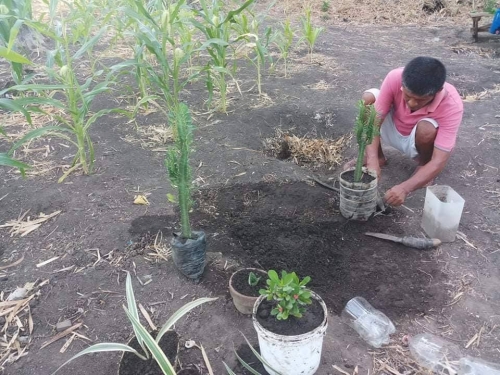Quarantine Eats: Sardines So Good!
Among the usual ayuda given to us during the quarantine is canned sardines. Filipinos often enjoy sardines straight from the can paired with hot rice or its usual sautéed version sometimes mixed with egg.
As the quarantine continues to be extended, Filipinos are in search of newer ways to cook the dish. But do not worry as we have collated three ways that canned sardines can be improved and made healthy.
Below are links to three (3) healthy recipes with canned sardines which we have collated for you from Panlasang Pinoy, a local online portal for healthy Filipino recipes.

Pandesal and Sardines Pizza
This recipe is perfect for those who love pan de sal for breakfast. The mild and savory taste of the traditional Filipino morning bread brings great harmony to the tangy and salty flavors of sardines, giving the canned good up by levels.
Find the recipe here: panlasangpinoy.com/pandesal-and-sardines-pizza/

Sardines with Patola and Miswa
Tickle your taste buds with this delectable recipe which is best served for lunch or dinner. The easy-to-cook soup works pairs well with warm rice. For the adventurous, you may also prepare its spicy version.
Find the recipe here: https://panlasangpinoy.com/misua-sardines-patola-recipe/

Spanish Sardines Pasta with Sun Dried Tomato and Chopped Olives
Impress your family with the Spanish Sardines Pasta with Sun Dried Tomato and Chopped Olives. As sosyal as the recipe’s name sounds, it is a really simple pasta dish that you can make for dinner. Feel free to modify the recipe according to your liking.
Find the recipe here: https://panlasangpinoy.com/spanish-sardines-pasta-with-sun-dried-tomato-and-chopped-olives/
Quarantine Eats: Top-up your Corned Beef
Among the usual ayuda given to us during the quarantine is canned corned beef. Well-loved by Filipinos, corned beef is usually served for breakfast.
As the quarantine continues to be extended, Filipinos have become bored of its usual sautéed version. But do not worry as there are a variety of ways that corned beef can be improved and made healthy.
Below are links to three (3) healthy recipes with corned beef which we have collated for you from Panlasang Pinoy, a local online portal for healthy Filipino recipes.

Tortang Corned Beef
Yes, corned beef can be turned into tasty omelets. This easy-to-make recipe is perfect for breakfast with a crispy texture that complements the savory and smooth taste that corned beef gives.
Find the recipe here.

Kalabasa and Corned Beef Nuggets
One cannot get enough with kalabasa and corned beef nuggets. Serve the healthy dish with ketchup and it is good to go as merienda or even lunch itself!
Find the recipe here.

Corned Beef Lomi Batangas Style
Batangas style lomi is characterized by thick noodles and sauce complete with various toppings. For this recipe, the main topping is corned beef meatballs, a healthy mix of corned beef and minced carrots. The lomi is perfect for dinners and cold weathers.
Find the recipe here.
Work From Home Reminder: Take Care of Your Eyes
Movement restrictions from the quarantine imposed in the Philippines has forced Filipinos to adapt to work-from-home arrangements. Even students are starting classes now online.
While this provided for protection for many Filipinos, it has adversely affected their eye health as they now sit for long hours in front of their gadgets.
The harsh radiation coming from glaring screens, forgetting to blink for long periods of time, and getting less rest because of flexible schedules all contribute to the degeneration of eye health.
Below are some ways to make sure that your eyes are in top shape.
- Eat healthy
The food you eat is important in taking proper care of your eyes. Fish with high omega-3 fatty acid content such as tuna, fresh fruits, and deep yellow and green leafy vegetables can help improve eyesight. - Exercise regularly
Exercising regularly helps prevent diseases such as diabetes, cardiac problems from high cholesterol and high blood, and morbid obesity. These problems lead to eye or vision problems. - Wear protective eyewear
Wear sunglasses when going out especially during noontime. Regularly consult with your eye doctor and wear prescription glasses when advised. Special anti-radiation lenses are available for people who work in front of computer screens. - Avoid smoking
Smoking increases the risk of developing macular degeneration, damage to the optic nerves, and other age-related eye problems. - 20-20-20 rule
To reduce eye strain from working in front of the computer, every 20 minutes, look for a space about 20 feet and stare for 20 seconds.
Related read: https://medlineplus.gov/eyecare.html
Quarantine Eats: 3 Healthy Recipes with Malunggay
The malunggay plant, also known as moringa or horseradish plant, is widely popular among Filipinos not only for its use in local soups and broth, but also for its high nutritional value.
Malunggay leaves are rich in Vitamins A to E, Calcium, Potassium, and Protein. All of which lead to finer motor skills, strengthened immune system, and improved blood circulation.
Lactating mothers can benefit from the “superfood” because it helps to increase breast milk production. For people aiming for weight loss, the high fiber content of malunggay may contribute to detoxification and appetite control.
The best thing about malunggay is its availability and the fact that it is almost always free. Commonly found around neighborhoods, people often share these from one household to another for use as needed.
While quarantine is still ongoing, below are links to three (3) healthy recipes with malunggay which we have collated for you from Panlasang Pinoy, a local online portal for healthy Filipino recipes

Chicken Sotanghon Soup with Malunggay and Sayote
This recipe is perfect for rainy days and when one is under the weather. A comfort food to many, the chicken sotanghon soup with malunggay and sayote is a proof that healthy food can be delicious.
Find the recipe here: panlasangpinoy.com/chicken-sotanghon-soup-with-malunggay-and-sayote/

Tinolang Tahong with Malunggay
This recipe is a kind of mussel soup which combines the mussels’ rich salty taste of the sea and the strong aroma from ginger broth, lemongrass, and malunggay. The flavorful tinolang tahong with
Malunggay will surely be another dish to your list of favorites.
Find the recipe here: panlasangpinoy.com/tinolang-tahong-with-malunggay/

Ginisang Sitaw, Kalabasa, at Malunggay with Shrimp
This recipe is a splendid mix of squash and shrimp which contrasts the green from string beans and malunggay. The dish, perfect for lunch or dinner, is as packed with nutrients as it is visually appetizing.
Find the recipe here:
panlasangpinoy.com/ginisang-sitaw-kalabasa-at-malunggay-with-shrimp-sauteed-butternut-squash-with-shrimp/
Munchkins, anyone?
Rags to funds: A livelihood program
How to Hug During Pandemic?
How to hug during a pandemic? The New Time Times has asked scientists who study airborne viruses to teach us the safest way to hug. See posters for details. For more information, pop over to nyti.ms/37hWute
#NagkahiusaBatokCOVID19 #CDOCOVID19Response #iCanDOit #HealAsOne #COVIDI19PH





COVID-19 Reflection: In safe hands

COVID-19 Reflection: Bring back story-reading for children
Family garden: Source of food and extra income amid COVID-19



















 World Health Organization
World Health Organization Department of Health
Department of Health 

























